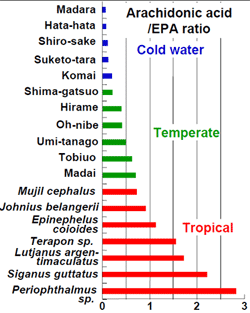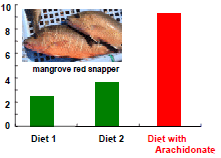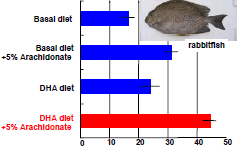Arachidonic Acid can Help the Aquaculture Industry to Take off in Developing Countries “Hatcheries in the Tropics require arachidonic acid for stable fry production”
Description
Aquaculture contributes significantly to food production, incomes and jobs in developing regions. However, the persistent constraint in aquaculture development is presently the supply of good quality seeds (fry) in quantity. Hatcheries are expected to provide stable fry supply for farmers, but fry production is often highly variable due to low survival rates. During the period 2002–2005, the Southeast Asian Fisheries Development Center - Aquaculture Department (SEAFDEC/AQD, Iloilo, Philippines) and JIRCAS have collaborated on studies aimed at developing advanced diets to improve the quality and production of eggs, larvae and seedstock for tropical marine fish species.
The most striking difference between cold water fish species and tropical fish species is that arachidonic acid, which is found in only minor quantities in cold water fish species with their high EPA levels, is one of the major essential fatty acids in the ovaries, testes, eggs and muscles of tropical fish species from mangrove areas or coral reefs in the Philippines, Malaysia and Ishigaki, Japan. It is notable that the major essential fatty acids in tropical fish species are DHA and arachidonic acid (not EPA) at a ratio of about 2:1. This result suggests that a dietary ratio of DHA/arachidonic acid (not EPA) of about 2 or greater can be recommended as an ideal regimen for broodstock of tropical fish species.
Thus, arachidonic acid is a major fatty acid widely distributed in tropical marine fish species and is likely to be important to reproduction and larval/fry performance. However, most studies on essential fatty acids in relation to fry production have been focused on EPA and DHA, and the potential value of arachidonic acid has not been applied to fry production technologies for tropical and subtropical fish species.
In the mangrove red snapper, total egg production and total number of spawn can be clearly improved providing a formulated diet containing arachidonic acid at 5 g/kg. Moreover, this diet can increase the percentage of normal larvae and boosts the cumulative survival rate to more than twice the level of those on diets without arachidonic acid. Rabbitfish fry, when fed rotifers or brine shrimps enriched with a combination of DHA and arachidonic acid, always showed the best survival rate. We conclude that adding arachidonic acid to broodstock diets or larval feeds dramatically improves seed production. Improved hatchery production of seedstocks can thereby help aquaculture take off in the developing tropical countries.
Figure, table
-
Fig.1 Arachidonic acid levels are higher in tropical fishes than in cold water fishes. -
Fig.2 Dietary arachidonicacid improves egg production.
Total egg production (x106) -
Fig.3 Arachidonic acid improves survival of rabbitfish fry.
Survival (%)
- Affiliation
-
Japan International Research Center for Agricultural Sciences Fisheries Division
- Term of research
-
FY2005(FY2001~2005)
- Responsible researcher
-
OGATA Hiroshi ( Fisheries Division )
SULOMA Ashrah ( Cairo University )
AHMED Kashfia ( Ibaraki University )
CHAVEZ Denny R. ( Southeast Asian Fisheries Development Center )
GARIBAY Esteban S. ( Southeast Asian Fisheries Development Center )
FURUITA Hirofumi ( National Research Institute of Aquaculture )
Chong Ving-Ching ( University of Malaya )
- ほか
- Publication, etc.
-
Ogata, H.Y., Emata, A.C., et al. (2004): Fatty acid composition of five candidate aquaculture species in Central Philippines. Aquaculture, 236, 361-375.
- Japanese PDF
-
2005_seikajouhou_A4_ja_Part15.pdf510.33 KB



